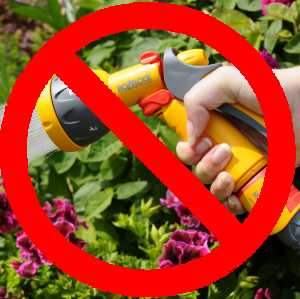Here in Britain summer usually consists of grey skies and rain with three fine days followed by a thunderstorm. Just occasionally we have a glorious summer, blue skies and blazing sun to rival any Spanish resort.
 The downside of a good summer is lack of water for the garden followed usually by a hosepipe ban.
The downside of a good summer is lack of water for the garden followed usually by a hosepipe ban.
Now let’s get it straight, there is no shortage of water in the UK in most of the UK. There is a shortage of water storage capacity that make coping with exceptional dry years difficult. Not to mention leaks in the distribution system that waste huge amounts of water.
However, whatever I think of the water monopolies, a ban is a ban and a £1,000 fine can be imposed for cheating, so let’s consider the options.
Saving Your Own Water
First of all, saving your own water is a good idea although a couple of small water butts won’t keep a large vegetable plot going for very long. If you have your own collected stored water, you can legally use a hosepipe to deliver it to your plot. You can buy electric submersible water pumps if your butts don’t have enough head to give you pressure.
Efficient Watering with a Soaker Hose
If you don’t have stored water and are faced with keeping things going with a watering can these tips should help.
Coping with Drought and Hosepipe Ban
Mulching the soil with compost will reduce evaporation so reducing the need to water. The way this works is that water is sucked up through small spaces in the soil to the surface. This is known as capillary action. Breaking the connection with a mulch really does help so long as the mulch isn’t compacted onto the surface.
If you can’t mulch, then hoe to break up the surface of the soil. This will again stop that capillary action aiding evaporation.
Don’t water unless you need to. This might seem obvious but you’d be surprised how often people water when there is absolutely no need to. Check by sticking your finger into the soil or scraping off the surface soil with a trowel. Often it’s quite damp a few inches down.
When you do need to water, water thoroughly. Light sprinkling and often will only wet the surface of the soil so the plant roots head up for the water and are very vulnerable to heat and hoeing. Much better to water properly every 3 or 4 days.
It’s easier to carry two full cans than one. You’re more balanced. You can pick up cheap plastic watering cans for a couple of pounds or less in lots of stores.
If your water supply is a long way from the crops, then invest in another couple of cans and you can take your filled cans down to the crop in a wheelbarrow.
And if all else fails – pray for rain!
Growing Guides, Information & Articles
- 3 Creative Ways To Beautify Your Garden
- 6 Ways to Enjoy Your Garden More This Summer
- Cats Toileting: How to Stop Cats using Garden or Veg Plot as a Toilet
- Desert Botanical Garden – what makes it so special?
- Full Spectrum Light – Grow Lighting using LED
- Garden Hints & Tips
- Garden Pests – Rabbits, Deer, Pigeons, Badgers
- How Fast Does Cherry Laurel Grow?
- How Inflatable Hot Tubs Improve Your Garden Ten Fold
- How to Care for a Peace Lily Indoors: Step-by-Step Guide
- How to Get the Most Out of Your Garden
- How To Give Your Garden A Makeover During Lockdown
- How to Grow Gladiolus in Your Garden
- How To Make A Side Income From Your Garden
- How to Protect Your Vegetable Garden from the Wind
- How to take care of your pond
- Microgreens – How to Grow Micro-greens Winter & Summer
- Modern Garden Ideas Featuring an Outdoor Firepit
- Planning a garden or allotment clearance
- Redesigning flower beds – How to do it
- Repair Rather Than Replace Old Garden Machinery and Power Tools
- Starting Them Young: 6 Homesteading Skills to Teach Children
- The Role of Campus Gardens in Student Mental Health and Well-being
- Top tips for amateur gardeners: get started today
- Why are LED Horticultural Grow Lights Purple?
- Zen Garden for Meditative Space
- Best Temperatures for Seed Germination
- Raised Beds – Vegetable Growing in Raised Beds
- Seed Saving
- Lawn Care Guides and Advice
- 10 Ways to Increase the Aesthetic Appeal of Your Backyard
- Fluid Seed Sowing & Seed Pre-Germination
- Home Made Pesticides & Unlicensed Use of Pesticides
- Decorative Garden Arches – Roman, Gothic, Ogee Garden Arches
- 5 Popular Uses for Log Cabins
- Grow Your Own Vegetables, Fruit, Herbs & Nuts
- Weed Control
- Gardening And The Importance Of Water Quality
- How to Build a Concrete Garden Path
- Concrete Garden Path Construction – Step by Step Photo Guide
- How Can Gardeners Cope with Climate Change?
- Gardening & Growing Vegetables Under a Hosepipe Ban
- Water Conservation: Garden Techniques
- Flood! Safe Growing & Harvesting of Crops After a Flood
- Day Length and Growing Plants
- Gardener’s Back Pain – Look After Your Back in the Garden
- Become an Urban Farmer and Start Growing Potted Plants
- Allotment Vegetable Plot Planning Software
- Start Your Seeds Indoors For A Jump On Spring Planting
- An Eco-Friendly Garden Backyard – Green Gardening
- Lunar Gardening, planting and gardening according to the phase of the Moon



